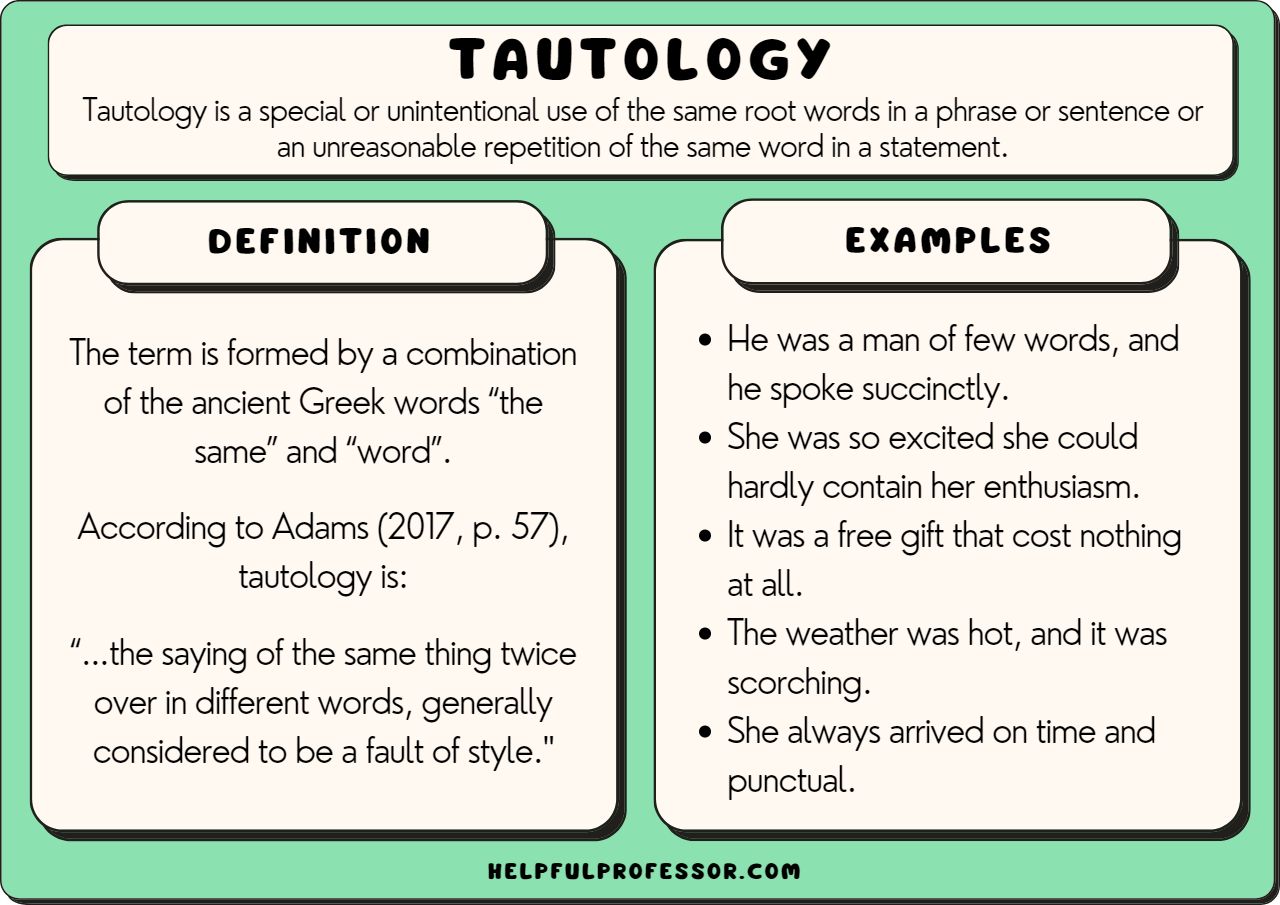
In the realm of defining terms, tautological definitions hold a unique place. They provide a succinct and self-referential explanation, making them a subject of interest across various fields. This comprehensive guide delves into the concept of tautological definitions, their types, usage, and strategies for avoiding them in writing.
Tautological definitions are statements that essentially restate the term being defined. They serve to clarify the meaning of a word or concept by using synonymous or closely related terms. While they can be useful in certain contexts, it’s crucial to understand their limitations and use them judiciously.
Tautological Definition: A Deep Dive

A tautological definition is a type of definition that restates the term being defined using different words or phrases. It does not provide any additional information or explanation, but simply repeats the concept in a slightly different form.
Tautological definitions are often used in technical writing, legal documents, and philosophical discussions. They can be useful for clarifying a term’s meaning within a specific context, but they can also be misleading or confusing if not used carefully.
Types of Tautological Definitions
- Circular definitionsdefine a term by using the term itself in the definition. For example, “A circle is a round shape.” This type of definition is obviously tautological and does not provide any useful information.
- Trivial definitionsdefine a term by using a synonym or near-synonym. For example, “A dog is a canine.” This type of definition is also tautological, but it may be somewhat more useful than a circular definition because it provides a different perspective on the term.
- Analytic definitionsdefine a term by breaking it down into its component parts. For example, “A triangle is a polygon with three sides.” This type of definition is not tautological because it provides new information about the term being defined.
Impact and Usage of Tautological Definitions
Tautological definitions can be useful in certain contexts, but they can also be misleading or confusing. Here are some of the advantages and disadvantages of using tautological definitions:
- Advantages
- Can be used to clarify a term’s meaning within a specific context.
- Can be helpful for teaching new concepts.
- Can be used to create a shared understanding of a term among a group of people.
- Disadvantages
- Can be misleading or confusing if not used carefully.
- Can be difficult to understand for people who are not familiar with the term being defined.
- Can lead to circular reasoning.
Avoiding Tautological Definitions
It is important to avoid using tautological definitions when writing. Instead, try to use clear and concise definitions that provide new information about the term being defined. Here are some tips for avoiding tautological definitions:
- Use a dictionary or thesaurus to find synonyms or near-synonyms for the term you are defining.
- Break the term down into its component parts and define each part separately.
- Use examples to illustrate the meaning of the term.
Tautological Definitions in Practice
Tautological definitions are often used in technical writing, legal documents, and philosophical discussions. Here are some examples of tautological definitions from these fields:
- Technical writing:“A computer is a device that can be programmed to carry out a set of instructions.” (This definition is circular because it uses the term “computer” in the definition of “computer.”)
- Legal documents:“A contract is an agreement between two or more parties that creates a legal obligation.” (This definition is trivial because it simply restates the term “contract” in different words.)
- Philosophical discussions:“Knowledge is justified true belief.” (This definition is analytic because it breaks down the term “knowledge” into its component parts and defines each part separately.)
Conclusive Thoughts: Tautological Definition

In conclusion, tautological definitions can be valuable tools for clarifying terms within specific contexts. However, their potential for redundancy and circularity highlights the importance of using them sparingly. By employing strategies to avoid tautological definitions and striving for clarity and precision in writing, we can ensure effective communication and a deeper understanding of the concepts we discuss.
FAQ Compilation
What is the purpose of a tautological definition?
Tautological definitions aim to clarify the meaning of a term by restating it using synonymous or closely related terms.
What are the different types of tautological definitions?
Tautological definitions can be categorized as circular, trivial, or analytic, depending on their structure and characteristics.
When should tautological definitions be avoided?
Tautological definitions should be avoided when they lead to redundancy or circularity, obscuring rather than clarifying the meaning of a term.





